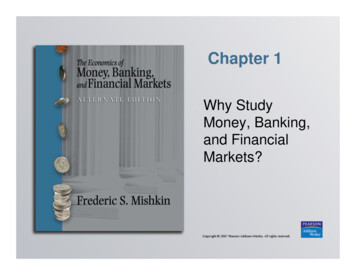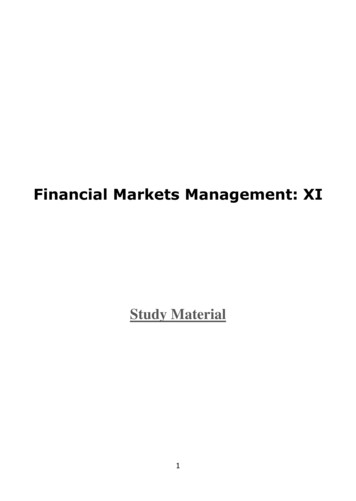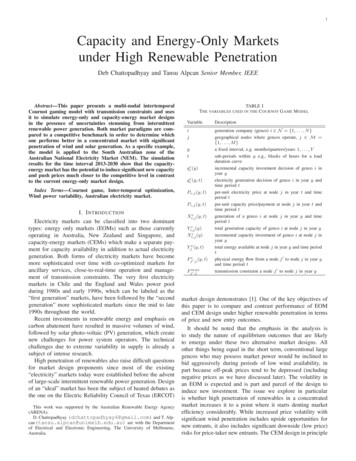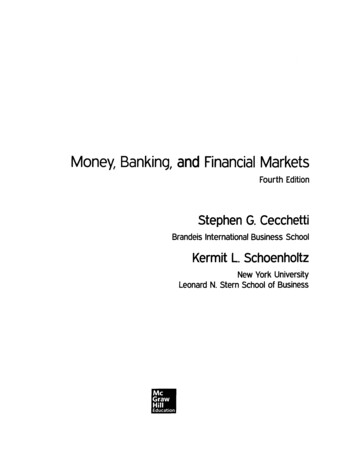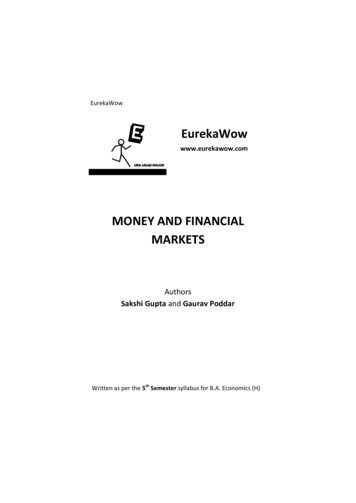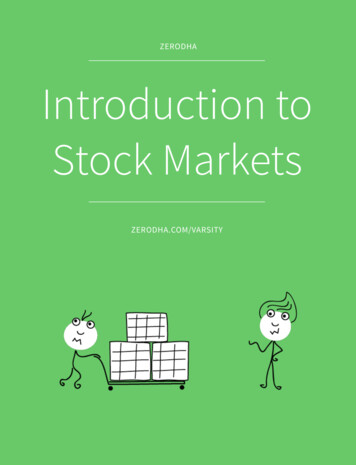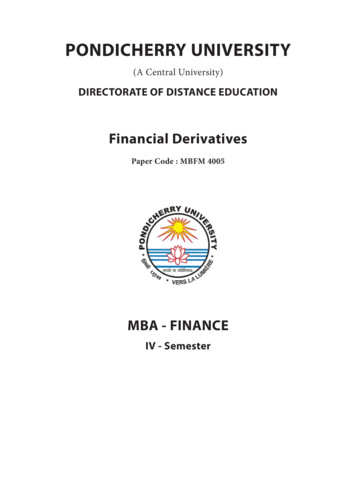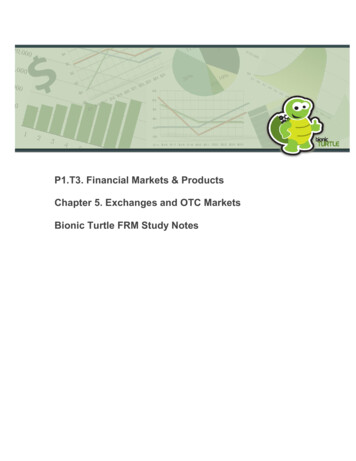
Transcription
P1.T3. Financial Markets & ProductsChapter 5. Exchanges and OTC MarketsBionic Turtle FRM Study Notes
CHAPTER 5. EXCHANGES AND OTC MARKETS . 3DESCRIBE HOW EXCHANGES CAN BE USED TO ALLEVIATE COUNTERPARTY RISK. DESCRIBENETTING AND DESCRIBE A NETTING PROCESS . 3EXPLAIN THE DEVELOPMENTS IN CLEARING THAT REDUCE RISK. . 5DESCRIBE THE IMPLEMENTATION OF A MARGINING PROCESS AND EXPLAIN THE DETERMINANTSOF INITIAL AND VARIATION MARGIN REQUIREMENTS. . 10COMPARE EXCHANGE-TRADED & OTC MARKETS AND DESCRIBE THEIR USES. . 11IDENTIFY THE CLASSES OF DERIVATIVES SECURITIES AND EXPLAIN THE RISK ASSOCIATED WITHTHEM. . 15IDENTIFY RISKS ASSOCIATED WITH OTC MARKETS AND EXPLAIN HOW THESE RISKS CAN BEMITIGATED. . 20DESCRIBE THE ROLE OF COLLATERALIZATION IN THE OVER-THE-COUNTER MARKET ANDCOMPARE IT TO THE MARGINING SYSTEM. . 22EXPLAIN THE USE OF SPECIAL PURPOSE VEHICLES (SPVS) IN THE OTC DERIVATIVES MARKET. 232
Chapter 5. Exchanges and OTC Markets Describe how exchanges can be used to alleviate counterparty risk. Explain the developments in clearing that reduce risk. Describe netting and describe a netting process. Describe the implementation of a margining process and explain the determinantsof initial and variation margin requirements. Compare exchange-traded and OTC markets and describe their uses. Identify the classes of derivatives securities & explain the risk associated withthem. Identify risks associated with OTC markets & explain how risks can be mitigated. Describe the role of collateralization in the over-the-counter market and compare itto the margining system. Explain the use of special purpose vehicles (SPVs) in the OTC derivatives market.Describe how exchanges can be used to alleviate counterparty risk.Describe netting and describe a netting process.Exchanges perform useful functions to expandeconomic activity. Originally, exchanges were simplyforums for entities to trade. The modern exchange hasstandardized contracts, settlement support, andcounterparty risk management. Among the list ofactivities exchanges facilitate are: Product standardization. In modernexchanges, such as the Chicago Board ofOptions Exchange (CBOE) or the New YorkStock Exchange (NYSE), contracts are standardized. For instance, a buyerpurchases one share of Ford Motor Company stock and the seller is selling exactlyone share of Ford Motor Company. There is no debate about what a share means.Similarly, the CBOE standardizes option contracts by ensuring each option has aclearly stated preset price and date. By standardizing products, exchanges make iteasier for trading to occur. Typical standardized items include:oQuotation price minimum increments.oMaturity dates.oDelivery location.oThe method or mechanism for delivery.oThe grade, form, or physical features ofthe underlying asset to be delivered.3
Trading venue. Exchanges offer a central location through which trading can occur.Although typically a physical location, such as the NYSE, the trading venue does notnecessarily need to be physically located in a specific geographic location. Tradingvenues are increasingly turning to electronic exchange business. By requirement,exchanges do some due diligence and limit access to the exchange to approvedentities that will honor the rules of the exchange. Price discovery. One of the most important aspects of exchanges is that they offerprice discovery. Price discovery is the process of entities finding out what theirproduct is worth. Liquidity. Another important aspect of exchanges is liquidity. Liquidity refers to theability to buy and sell an asset quickly at a reasonable bid-ask spread. Reporting services: Exchanges offer buyers, sellers, data vendors, and datasubscribers to information on price discovery and other reported information.Counterparty RiskExchanges are intermediaries, facilitating a placewhere members can trade with each other. In eachexchange, both parties are taking on counterparty risk.Counterparty risk is the possibility that counterpartiesto a transaction could potentially renege on agreedupon transactions. How do exchanges help withcounterparty risk? There are two main avenuesthrough which exchanges help minimize counterparty risk. The first way exchanges address counterparty risk is through margin requirements.Imposing margin requirements is when assets are transferred from one trader toanother through an intermediary (the exchange). The presence of the intermediaryminimizes counterparty default risk.o For instance, suppose Trader Alphabuys 25,000 bushels of corn fromTrader Beta in October for 500 centsper bushel. Further, suppose that theprice of corn drops to 400 cents perbushel the day after the trade wasmade. Trade Alpha would want torenege on his purchase if possible.What could prevent Trader Alpha fromreneging? One way is through a margin requirement. In this example, TraderBeta may request that Trader Alpha deposit 100 cents per bushel with theexchange ( 25,000). If Trader Alpha tries to renege, he may lose the marginamount with nothing in return.The second way exchanges address counterparty risk is by providing methods forimproving clearing and thereby minimizing counterparty risk. Clearing refers toreconciling and resolving contracts between parties to a transaction. The clearingprocess occurs between trade execution and trade settlement.4
NettingNetting refers to offsetting transactions, or “netting” short and long positions. For instance,suppose Trader Alpha purchases 10,000 bushels of corn for 1 per bushel from Trader Betaand Trader Beta purchases 10,000 bushels of corn for 1.30 per bushel from Trader Alpha.Presuming both have the same delivery date, rather than each entity delivering the items,Trader Beta could simply pay Trader Alpha 3,000 and be done with the transaction. In thiscase, Trader Alpha and Trader Beta are netting the two transactions against each other.Overall, there are three broad categories of netting – direct clearing, ring clearing, andcomplete clearing – addressed in the following section.Explain the developments in clearing that reduce risk.TradeexecutionClearingSettlementClearing is the process of reconciling contracts between counterparties. In terms of timing,the clearing process begins when buyers and sellers agree on a price and when the actualsettlement of the trade execution takes place (after all legal obligations are met).How do buyers and sellers ensure that a trade execution results in a final settlement? Sucha situation may occur when there is a large change in price from the trade execution dateand when the final settlement is to take place. Exchanges have developed two methods toreduce non-settlement risk – margining and netting. Margining refers to exchange members putting up cash or other assets to coverpotential gains and/or losses in the respective positions. There are two types ofmargining – variation margin and initial margin.oVariation margin allows for the margin amounts to vary.oInitial margin allows for extra coverage against losses in case partiesdefault.Netting involves the offsetting of contracts, or “netting” short and long positions in aposition. which reduces the exposure of counterparties and the underlying network towhich they are exposed. It reduces the costs of maintaining open positions such asvia the margins needing to be posted. Netting can be seen in all of the three forms ofclearing that have developed, namely direct clearing, ring clearing, and completeclearing.5
Direct clearingDirect clearing is the simplest and oldest of the clearing processes. It involves a mutual, twoparty agreement on the reconciliation of commitments. In a direct clearing arrangement, onecounterparty delivers the asset(s) to the other counterparty, who delivers the cash inexchange for the asset. This is a direct clearing arrangement and is what most people thathave ever traded baseball cards or been involved in basic trading are used to.Direct clearing can also refer to offsetting trades if counterparties have offsetting trades,depicted in the following figure.Direct clearing with offsetting tradesIn the example here, counterparties Alpha and Beta have offsetting positions with each otherin the same contracts: Alpha has an agreement to buy 100contracts from Beta for 110 at aspecified future date. Beta has a reverse position with Alphabut at a lower price of 107. This offsetting direct clearing ispossible with standardized contractsthat make contracts fungible. To improve the transaction, rather thanAlpha and Beta physically exchanging100 contracts with associatedpayments of 10,700 and 11,000 toone another, the parties could use a“payment of difference”arrangement. In this case, Beta wouldpay Alpha 300. Payment ofdifference, rather than delivery, whichbecame common in futures markets toreduce problems associated withcreditworthiness. Of course, this typeof arrangement requires some form ofconnection between the parties to thetransaction. In this example, the payment of difference could occur on the settlement date or anytime before that date. In the OTC derivatives market, this “payment ofdifference” form of direct clearing is netting.Of note, in this example of direct clearing, the original counterparties are still exposed toeach other. The exposure, though, is minimized by using a payment of differencesarrangement. It is also important to note that although exchanges facilitate these types oftransactions by defining standard contractual terms, exchanges have a limited additional roleto play in such a structure. They would generally play the role similar to a mediator should adispute materialize.6
suppose Trader Alpha purchases 10,000 bushels of corn for 1 per bushel from Trader Beta and Trader Beta purchases 10,000 bushels of corn for 1.30 per bushel from Trader Alpha. Presuming both have the same delivery date, rather than each entity delivering the items, Trader Beta could simply pay Trade

